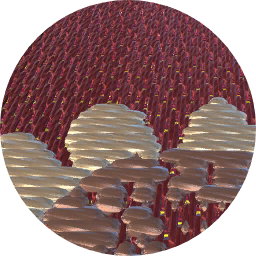Description
Hanging of tapestry-woven wool in 2/2 twill backed with red silk and faced with striped satin. Made in Kerman in south-east Iran in the 1870s. Purchased from Messrs. Londos & Co. London for £15.
Kerman dominated sal production in19th century Iran and although Yezd was in competition, the products of the Kerman looms were finer.
'The material called koork, of which the shawls are made, is the under wool of a particular kind of white goat. Numerous flocks are to be seen in the neighbourhood of Kerman ... I made enquiries at Kerman why the koork-producing goats were only to be found in that neighbourhood, and was informed that in that district the rapid descent from the high plateau of Persia to the plains near the sea afforded the means of keeping the flocks throughout the year in an almost even temperature and in abundant pastures, with a much shorter distance between summer and winter quarters than in other parts of Persia and that such an even climate without long distances to traverse in the course of migration was necessary to the delicate constitution of the animal, or rather to the softness of its wool. The whole of the koork is not made use of in the looms of Kerman, a large quantity being annually exported to Amritsur in upper India, where it is manufactured into false Cashmere shawls.' Quoted from 'Persian Art' by Major Murdoch Smith [London, 1877 p.48]. [2002]
Woollen twill tapestry faced with woven and brocaded silk and metal thread bias-cut satin and backed with silk satin.
Warp: dark blue, blue, red, white and yellow wool. The yellow is used in the centre but its top and bottom have been dyed dark blue to form the dark ground needed for the main border. The other colours form the stripes for the borders.
Weft: wool; dark blue, blue, light blue, dark green, green, red, light red, yellow, white.
The central panel is 134 cm long and has a yellow ground. It contains a lobed arch outlined with a white border with a green floral meander with red and green blossoms and yellow details. Towards the lower end is a shallow tray decorated with a floral pattern in white, red, green and yellow; this supports a white vase decorated with flowers. To either side is a smaller vase with a single carnation fan in red, dark blue, light blue and yellow. The central vase holds a single large rosette and two cascading stems of small blossoms. In the upper central field there is a smaller tray with a small vase from which emerges a fat bifurcated leaf with a white ground filled with a multi-flowering stem. Below the apex of the arch is a large carnation. The rest of the ground is densely packed with fairly large flowers, leaves etc.. These include irises, carnations and buds. The lower corner of the central panel have quarter medallions outlined in white with a red ground and similar floral patterns. Above these, along the sides of the arch is a half cypress tree with a yellow ground and green outline. The spandrels have a red ground densely packed with floral motifs similar to the main field, mainly in blue and green.
Main border: dark green ground with large inward facing red carnation fans alternating with sprays of blue irises and sprays of red flowers and with a smaller red and white rosette.
Inner and outer borders: white ground with a green meander and red or deep yellow blossoms. Down the sides the ground is white but along the top and bottom the ground appears to be light blue because of the change in the colour of the warp threads.
Note: this is a wonderful piece of both design and weaving.
Facing: bias-cut silk satin; striped; [1] white ground with an isolated floral sprig with a dark brown flower and a pair of green leaves, alternating with a larger boteh-shaped motif like a bunch of grapes in light brown and metal thread with green leaves. [2] light brown ground with a similar small sprig in pink alternating with a large sprig of three pink flowers, metal thread and green leaves. These stripes are separated by a narrow composite stripe of yellow, dark brown and yellow.
Warp: white, dark brown, yellow and light brown silk, Z-twist
Weft: green, pink and dark brown silk.
Metal thread: silver stripe open S-wound on yellow silk.
Note: the green silk weft is woven; the pink, dark brown and metal threads are brocaded.
Backing: pieced; unpatterned red silk satin. There is a selvedge visible and it has a green and white stripe.
tapestry-woven woollen twill; shawl material, 1810-1860, Kashmir



